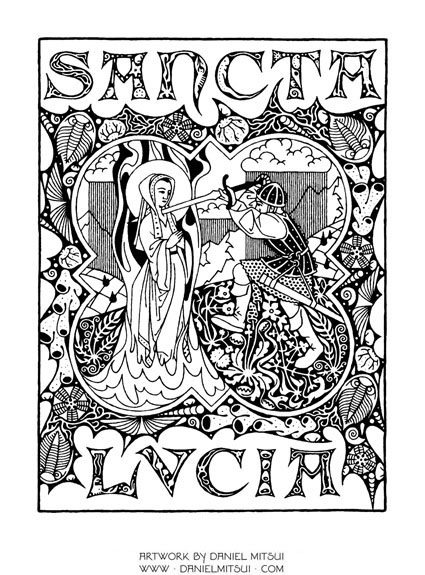
The Saints: An Adult Coloring Book was published by Ave Maria Press in 2016. It measures 8 1/2" × 11" and contains thirty coloring pages, each featuring a different saint. These are based on drawings in a variety of styles. The Blessed Virgin Mary, John the Baptist, Peter and Paul are included, as are less familiar saints such as Gobnait and Drogo of Sebourg.
You can order this book from Ave Maria Press here: The Saints by Daniel Mitsui
Or through Amazon here: The Saints by Daniel Mitsui
This is my introduction to the book:
The images in this book are details from ink drawings that I made to illustrate the lives of saints. Some of the decorative borders and lettering are taken from other drawings and rearranged into the compositions here, but all of the artwork originally came from own hand.
As an artist, my preference is to draw saints from the Apostolic age, the age of the Fathers, and the Middle Ages. The task here is to construct an iconographic likeness of the holy man or woman - a different (and to me at least, more interesting) task than to represent a physical likeness known from photographs or portrait paintings.
When drawing saints who lived after Biblical times, I refer to the traditional hagiographies, those wonderful accounts of their miracle-filled lives. The Golden Legend is usually the first reference book that I pull off my shelf. It is a thirteenth-century encyclopedia of saints’ lives compiled from liturgical lectionaries and patristic writings. It represents the entire tradition better than any other single book.
When I first read The Golden Legend, I was impressed by the enormous wealth of information, and by the intellectual seriousness with which its compiler, Blessed Jacobus de Voragine, approached his task. He readily admits when a story is based on a doubtful source, or when different versions of it exist. Yet his attitude to the hagiographies is generous; he gives them the benefit of doubt whenever possible.
This starkly contrasts the attitudes of so many Christians of modern times, which are derisive, dismissive, or at best patronizing. It is cute, they may say, to draw St. Brendan celebrating Mass on the back of a whale, but of course we know that that didn’t really happen. Well, really? We do? What evidence is there against it? This is a very strange assertion for those who professes faith in an omnipotent God and in His revealed Word.
For St. Brendan’s whale is no less plausible than Jonah’s; the miracles of St. Nicholas are no more fantastic than the miracles of Elijah. The dragon defeated by St. Sylvester is no stranger than the dragon defeated by Daniel (a demonically-possessed crocodile would fit the description of either, although heraldic dragons are more fun to draw). No hagiography is stranger than the stories of the Old Testament and the stories of the New. What could be stranger than the Resurrection of Jesus Christ?
Of course, the Resurrection is an article of faith, something that a Christian is simply not permitted to disbelieve, and the words of the Old and New Testaments are inerrant; hagiographies are not (as Blessed Jacobus would be the first to admit). But our attitude toward the legends of the saints reveals and affects our attitude toward God, toward His creation, and toward His revelation.
We either live in a world in which these sort of things happen, or we do not.
DM
